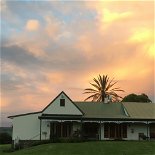Behind the Name "Spionkop"
The name Spion Kop or Spioenkop - ‘Spy or lookout hill’.
The name Spion Kop - Lookout Hill was given to this impressive hill by the Voortrekkers in 1837. This was the original Dutch spelling and is still the English version.
Spioenkop : Spy Hill is the term used by the Afrikaans speaking people of South Africa .
Spioenkop (Spion Kop) is a small hill on the Tugela River, a few miles south-west of Ladysmith, Natal Province, in South Africa. During the Second Boer War (South African War) the hill was the scene of a Boer victory over the British on 24 Jan 1900. In the battle, a column of British troops attempting to relieve Ladysmith under General Sir Redvers Buller was repulsed by a smaller Boer force.
Although the common English name for the battle is Spion Kop throughout the Commonwealth and its historical literature, the official South African Afrikaans name for the Battle is Spioenkop, which is in common use in South Africa and is the correct English spelling of the borrowed Afrikaans name; spioen means "spy" or "look-out", and kop means "hill" or "outcropping". Another variant that is sometimes found is the combination into Spionkop
‘The Kop’ at Anfield
The Lancashire Brigade comprised the majority of the force on Spioenkop, hence the ‘Kop End’ at the home of Liverpool football, Anfield. Indeed had you visited any football ground between Leeds and Liverpool 100 years ago the home supporters' end would have been a mound of earth and rubble from which the locals watched their team. It reminded them of the stories of ‘Spion Kop’ in the Boer War and over the years ‘Spion Kop’ became ‘The Kop’. As these mounds became grand stands some of them kept their names, the most famous being Anfield.



Share This Page